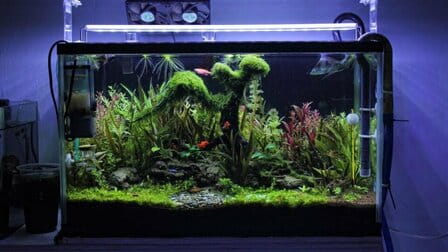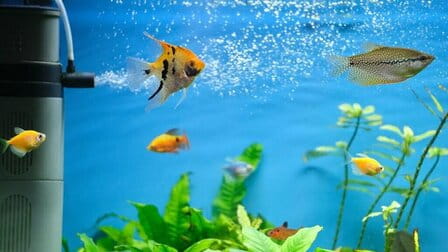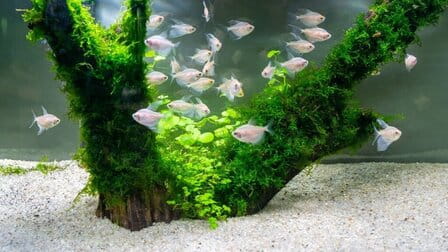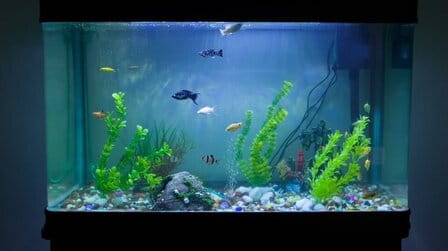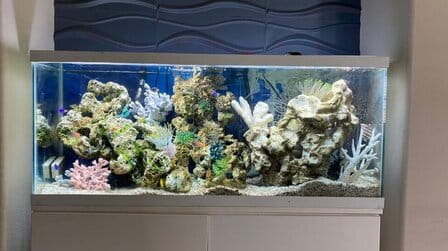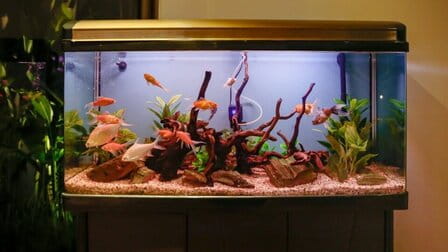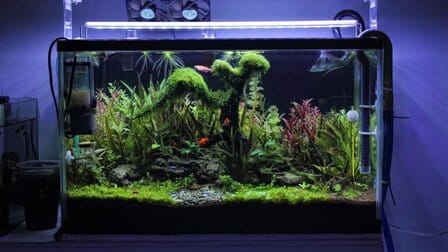A healthy and balanced aquarium relies on beneficial bacteria to break down fish waste, dead plant matter, and other organic debris that accumulates in the tank. From there, they will keep the water clear and prevent toxic ammonia and nitrites from building up. As you know, these bacteria live in filter media and on solid surfaces in aquariums, like gravel, rocks, plants, and decorations, but it takes time for them to form. To learn more about the benefits of good bacteria for aquariums, let's find out below!
1. Benefits of good bacteria for aquarium
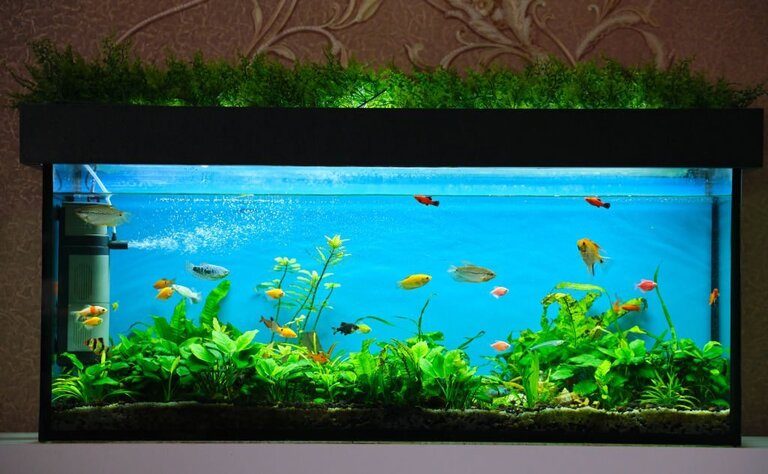
It is known that bacteria are single-celled microorganisms that can only be seen under a microscope. Virtually these microorganisms play an important role in the life of every living thing on earth.
Also depending on the type of organism, they will cause several agents that cause most diseases and spoilage of food.
It is known that beneficial bacteria are good bacteria that provide the necessary support for the growth and improvement of living beings.
And these bacteria help promote health conditions. It also maintains an ecological balance for the aquatic organisms present in the aquarium.
Besides, beneficial bacteria not only help decompose the corpse but also help with fermentation. They help with digestion, genetic engineering, pest control, bioremediation, and medicine.
They are natural recyclers. Beneficial bacteria convert rotting matter into important nutrients through various processes. From there, raising fish needs good bacteria for the aquarium to work properly.
Usually fish produce ammonia as a by-product. Beneficial bacteria play an important role in converting ammonia to nitrate through the nitrogen cycle.
2. Types of bacteria

Nitrosomonas and Nitrobacter are the two main types of nitrifying bacteria important to aquariums. It is responsible for the smooth operation of the aquarium. These two microorganisms perform the nitrification step of the Nitrogen Cycle; For this cycle helps to produce inorganic nitrogen that provides energy for the primary production of plankton.
It is known that this cycle is a biogeochemical cycle that converts the most abundant gas in the atmosphere, i.e. nitrogen, into various chemical forms that are ready to be used by living organisms.
- Nitrosomonas: Gram-negative bacteria belonging to Phylum Proteobacteria and also rod-shaped chemolitho bacteria. It is aerobic bacteria that can survive and live in the presence of oxygen. These are very useful in Bioremediation.
Nitrosomonas has also a unique feature of converting ammonia into nitrite. The process of converting ammonia to nitrite is called nitritation.
Especially in aquariums, Nitrosomonas is required to oxidize ammonia produced by fish to nitrite as a metabolic process. From there it supplies that nitrite to the second beneficial bacteria in the tank to convert it into the necessary nutrients.
These play an important role in the nitrogen cycle. They start the process of supplying nitrogen to aquatic plants, limiting the fixation of carbon dioxide.
- Nitrobacter: belongs to the same genus, the same phylum, and even has the same shape as Nitrosomonas. This Nitrobacter converts nitrite provided by Nitrosomonas into nitrate.
It is known that two types of aerobic bacteria thrive in the presence of oxygen. Oxygen is an important element in existence.
When two types of nitrifying bacteria Nitrosomonas and Nitrobacter are close together. Thus, it will convert ammonia to nitrite and make it automatically available to Nitrobacter for further nitrification.
Unlike Nitrosomonas, these bacteria derive energy from the oxidation of ammonium ions, nitrites, into nitrates. Thus, nitrification produces energy. Moreover, it uses the same energy for metabolism and carbon fixation.
3. Nitrogen cycle
The nitrogen cycle in the aquarium will be different from the cycle in the atmosphere. It is a less-cycle and more biochemical process. This cycle involves the persistent chemical breakdown of nitrogen compounds: Ammonia to nitrite and nitrite to nitrate.
The nitrogen cycle consists of the following steps in the aquarium:
Formation of ammonia

Ammonia is a deadly poison to fish living in aquariums. However, fish is also a major contributor to ammonia production in the form of urea and fish protein. The decomposition of the waste products of fish, plants, and other organisms produces ammonia in the aquarium.
Formation of nitrite

Most nitrogen cycles involve converting ammonia into ammonium ions, i.e. nitrites. When Nitrosomonas bacteria oxidize nitrogen present in the ammonium molecule, nitrite is produced. Nitrite is the most common cause of fish death in aquariums.
Nitrification

When Nitrosomonas converts ammonia to nitrite. The second bacterium Nitrobacter works to convert nitrite into a less toxic nitrogen compound, nitrate.
As Nitrobacter oxidizes ammonium ions to nitrates of their metabolism, nitrate production takes place. They are the end product of the nitrogen cycle.
Plants
At the end of the Nitrogen cycle, the most important cycle occurs when plants remove and use the nitrates produced; Consumption of nitrate makes the water in the aquarium less toxic and healthy for the fish.
4. Water clarity

Thanks to Beneficial Bacteria that remove the decayed and decayed plant and fish carcasses to make the water in the tank clean.
5. Maintain pH

Thanks to the decomposition and accumulation of waste, the pH of the water is reduced. The bacteria that reside on the filter media help remove waste, thereby balancing the pH.
6. Low toxicity

Most nitrogen cycles carried out by bacteria remove ammonia from the water. This cycle indirectly helps to reduce water toxicity. Ammonia and nitrite are really toxic to fish.
7. Pollution control
In the process of the nitrogen cycle, beneficial bacteria are converting ammonia into nitrate. Thus, they will remove the pollutants present in the water.
8. How to add more good bacteria to the aquarium?

Increase the water temperature
Often beneficial bacteria can multiply faster in the tank when the water is warm.
For every nitrogen cycle, you should keep the water temperature between 85 and 90 degrees.
If the water temperature is more than 90 degrees, it will not only affect the nitrogen cycle but also affect the fish.
Aquariums have a wide variety of fish, it's best to check what temperature they prefer and remove them during the nitrogen cycle if this is too high for them.
Increase oxygen levels

On the other hand, increasing the water temperature along with the oxygen level is guaranteed to increase beneficial bacteria in the aquarium.
You can also increase oxygen levels by adding an air pump to the aquarium.
In addition, the air pump will not make any distracting noises and can also help stabilize the pH in the aquarium.
And they also last a lifetime and are made with high-quality materials, so you'll never have to worry about fish or plants.
You just need to install the air pump that runs in the tank all day and the oxygen levels will increase.
Another way to increase the amount of oxygen in the aquarium is to increase the water flow.
You can also do this by adding wave generators to the tank and making sure they are properly aligned, which will allow them to generate more water pressure and increase water flow.
Turn off the lights
Bacteria grow quickly in the dark, however, the lights are not always turned off because the light makes it easier to see what's going on inside the aquarium.
Lights also help with maintenance and cleaning and are an essential part of the aquarium.
Anyway, you can turn off the lights at night before going to bed. It is also a smart idea to keep the aquarium out of sunlight as it can affect the growth of bacteria.
Let the filter run
The filter has a steady stream of water and very little light - two of the most important things beneficial bacteria need to thrive.
Invest in a filter that runs on the nitrogen cycle. The filter will keep the water clean and house bacteria water.
Since beneficial bacteria live inside the filter, care must be taken when cleaning the filter.
Tank water is a good choice because it does not contain chlorine.
Add filter media

This in turn accelerates the nitrogen cycle, which will also help remove ammonia from the aquarium as beneficial bacteria eat the ammonia and turn it into harmless compounds in the tank.
Adding filter media can speed up the process, and make sure the tank is set up to use only healthy fish.
Limit more fish
If fish continue to be supplemented, the bacteria will not have time to convert all the ammonia released from the waste and uneaten feed into harmless compounds.
As fish numbers increase, bacteria will become increasingly difficult, leading to fish death, which in turn can affect bacterial growth and the nitrogen cycle.
Conclusion
As mentioned above, the benefits of good bacteria for aquariums improve the water quality in the aquarium and enhance fish safety. In addition, it also plays a beneficial role in maintaining the right toxicity levels for pet fish.
Besides, it also helps to keep aquatic organisms that are difficult to grow in a confined environment. In addition, it is best to install a filter with biological media to provide enough space for bacteria to live. Depending on your needs, these bacteria will be selected for nitrate production and biofiltration.

